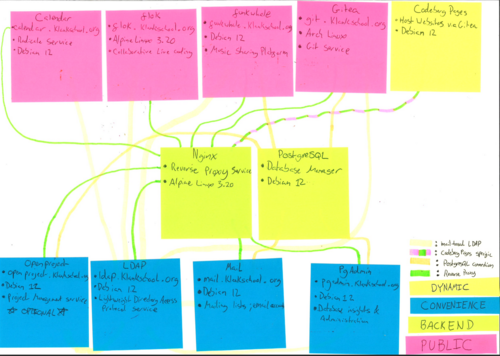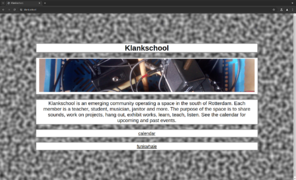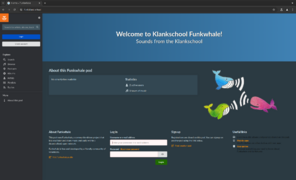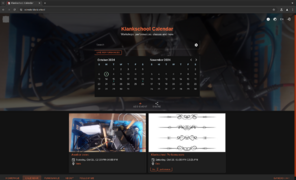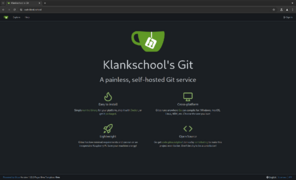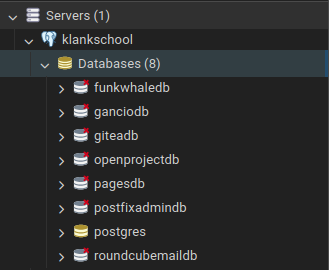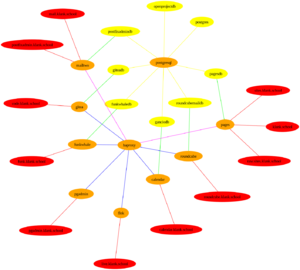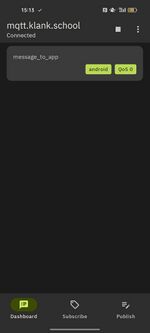User:Riviera/Rapid prototypes
September 19th 2024
incus-tramp.el
This file is an edit of Yc.S' lxd-tramp.el. It allows Emacs to TRAMP into Incus containers.
;;; incus-tramp.el --- TRAMP integration for incus containers -*- lexical-binding: t; -*-
;; Copyright (C) 2018 Yc.S <onixie@gmail.com>; 2024 Riviera Taylor <riviera@klankschool.org>
;; Author: Yc.S <onixie@gmail.com>; Riviera Taylor <riviera@klankschool.org>
;; URL: https://github.com/onixie/lxd-tramp.git
;; Keywords: incus, convenience
;; Version: 0.1
;; Package-Requires: ((emacs "24.4") (cl-lib "0.6"))
;; This file is NOT part of GNU Emacs.
;;; License:
;; This program is free software; you can redistribute it and/or modify
;; it under the terms of the GNU General Public License as published by
;; the Free Software Foundation, either version 3 of the License, or
;; (at your option) any later version.
;; This program is distributed in the hope that it will be useful,
;; but WITHOUT ANY WARRANTY; without even the implied warranty of
;; MERCHANTABILITY or FITNESS FOR A PARTICULAR PURPOSE. See the
;; GNU General Public License for more details.
;; You should have received a copy of the GNU General Public License
;; along with this program. If not, see <http://www.gnu.org/licenses/>.
;;; Commentary:
;;
;; `incus-tramp' offers a TRAMP method for Incus containers
;;
;; ## Usage
;;
;; Offers the TRAMP method `incus` to access running containers
;;
;; C-x C-f /incus:user@container:/path/to/file
;;
;; where
;; user is the user that you want to use (optional)
;; container is the id or name of the container
;;
;;; Code:
(eval-when-compile (require 'cl-lib))
(require 'tramp)
(require 'subr-x)
(defgroup incus-tramp nil
"TRAMP integration for incus containers."
:prefix "incus-tramp-";
:group 'applications
:link '(url-link :tag "GitHub" "https://github.com/onixie/lxd-tramp.git")
:link '(emacs-commentary-link :tag "Commentary" "lxd-tramp"))
(defcustom incus-tramp-incus-executable "incus"
"Path to incus executable."
:type 'string
:group 'incus-tramp)
;;;###autoload
(defconst incus-tramp-completion-function-alist
'((incus-tramp--parse-running-containers ""))
"Default list of (FUNCTION FILE) pairs to be examined for incus method.")
;;;###autoload
(defconst incus-tramp-method "incus"
"Method to connect to incus containers.")
(defun incus-tramp--running-containers ()
"Collect running container names."
(cl-rest
(cl-loop for line in (ignore-errors (process-lines incus-tramp-incus-executable
"list" "--columns=n")) ; Note: --format=csv only exists after version 2.13
for count from 1
when (cl-evenp count) collect (string-trim (substring line 1 -1)))))
(defun incus-tramp--parse-running-containers (&optional ignored)
"Return a list of (user host) tuples.
TRAMP calls this function with a filename which is IGNORED. The
user is an empty string because the incus TRAMP method uses bash
to connect to the default user containers."
(cl-loop for name in (incus-tramp--running-containers)
collect (list "" name)))
;;;###autoload
(defun incus-tramp-add-method ()
"Add incus tramp method.";
(add-to-list 'tramp-methods
`(,incus-tramp-method
(tramp-login-program ,incus-tramp-incus-executable)
(tramp-login-args (("exec") ("%h") ("--") ("su - %u")))
(tramp-remote-shell "/bin/sh")
(tramp-remote-shell-args ("-i" "-c")))))
;;;###autoload
(eval-after-load 'tramp
'(progn
(incus-tramp-add-method)
(tramp-set-completion-function incus-tramp-method
incus-tramp-completion-function-alist)))
(provide 'incus-tramp)
;; Local Variables:
;; indent-tabs-mode: nil
;; End:
;;; incus-tramp.el ends here
Incus List
This is a list of containers running inside the Klankserver. Each has an IPV4 address and a corresponding IPV6 address which I have redacted just in case....
$ incus list +-------------+---------+----------------------+-----------------------------------------------+-----------+-----------+ | NAME | STATE | IPV4 | IPV6 | TYPE | SNAPSHOTS | +-------------+---------+----------------------+-----------------------------------------------+-----------+-----------+ | calendar | RUNNING | REDACTED (eth0) | REDACTED (eth0) | CONTAINER | 0 | +-------------+---------+----------------------+-----------------------------------------------+-----------+-----------+ | flok | RUNNING | REDACTED (eth0) | REDACTED (eth0) | CONTAINER | 0 | +-------------+---------+----------------------+-----------------------------------------------+-----------+-----------+ | funkwhale | RUNNING | REDACTED (eth0) | REDACTED (eth0) | CONTAINER | 0 | +-------------+---------+----------------------+-----------------------------------------------+-----------+-----------+ | gitea | RUNNING | REDACTED (eth0) | REDACTED (eth0) | CONTAINER | 0 | +-------------+---------+----------------------+-----------------------------------------------+-----------+-----------+ | ldap | RUNNING | REDACTED (eth0) | REDACTED (eth0) | CONTAINER | 0 | +-------------+---------+----------------------+-----------------------------------------------+-----------+-----------+ | mail | RUNNING | REDACTED (eth0) | REDACTED (eth0) | CONTAINER | 0 | +-------------+---------+----------------------+-----------------------------------------------+-----------+-----------+ | nginx | RUNNING | REDACTED (eth0) | REDACTED (eth0) | CONTAINER | 0 | +-------------+---------+----------------------+-----------------------------------------------+-----------+-----------+ | openproject | RUNNING | REDACTED (eth0) | REDACTED (eth0) | CONTAINER | 0 | +-------------+---------+----------------------+-----------------------------------------------+-----------+-----------+ | pages | RUNNING | REDACTED (eth0) | REDACTED (eth0) | CONTAINER | 0 | +-------------+---------+----------------------+-----------------------------------------------+-----------+-----------+ | pgadmin | RUNNING | REDACTED (eth0) | REDACTED (eth0) | CONTAINER | 0 | +-------------+---------+----------------------+-----------------------------------------------+-----------+-----------+ | postgresql | RUNNING | REDACTED (eth0) | REDACTED (eth0) | CONTAINER | 0 | +-------------+---------+----------------------+-----------------------------------------------+-----------+-----------+ |
29 September 2024
Klankserver Service Types and Connections
I created a collection of README files on the klankserver with information about each container. The files detailed the purpose, endpoint, OS and name of each container as well as links to useful webpages. I then placed filtered information on post-it notes, which were colour-coordinated according to the type of the service. I placed these on a piece of A3 paper and drew lines with highlighters to represent the interactions between these containers. Doing this gave me insight into which services were most important (that is, public facing or backend) and which were merely for convenience. As such, I was able to prioritise which services would need setting up first and foremost.
2 October 2024
Some reflections on transcribing speech
The following text features half-baked reflections on transcribing interviews using AI software. More could be said about the relationship between Natural Language Processing and AI transcription models. Further researching Special Issue 13, as well as knitting the discussion of di-versionings with research into server maintenance practices are constructive next steps
I am planning to conduct several interviews with people about servers and server maintance. In preparation for this undertaking, I am practising transcribing interviews. I am motivated to do so following an execerise proposed in InterViews: Learning the craft of qualitative research interviews, by Brinkmann and Kvale (2015, p.70). Recently, I found a talk on Archive.org by Cristina Cochior and Julie Boschat-Thorez about vernacular language processing. I am guessing from the context that it was given at the Hackers and Designer’s Summer Camp in 2022. I decided to process the talk, albeit not an interview, with OpenAI’s Whisper.
The irony of transcribing a talk about vernacular language processing with OpenAI software was not lost on me. Whereas the software is accurate, it could not by itself reconstruct the formatting of vernaculars in the publication Vernaculars Come to Matter. This was most notable when the speakers performed a reading of excerpts from this spiral-bound text during the talk. The phantasmagoric through-line offered reminds me of TV adverts for compilation albums. How might this sensation be reflected in a transcription? For now, given that this is a rapid prototype, I have settled for re-using material from the VLTK wiki, formatting and all. Doing so leads me to questioning to what extent I have re-enforced ‘a binary opposition, between the natural and the artificial’ (Boschat-Thorez in Radio Echo Collective, 2022). There is a stark contrast within the mélange between the text yanked from hypertexts elsewhere and the speech processed by AI. Likewise, the language of the publication bled into the edited, computationally processed copy when omitted hyphenations were reintroduced to terms such as ‘re-formations’.
On the topic of errors, I decided to review the transcribed material several times. I often did so while listening to the talk at a slower pace. Although Brinkmann and Kvale’s text predates this software, I expect there were some pieces of software available a decade ago that had the ability to transcribe audio. Thus, these authors would likely have been cognisant of the influence of ever-advancing technology on the practice of transcribing. The form of accuracy which contemporary AI models strive for in transcribing speech arguably reflects (techno-)solutionism. As Radford et al. (n.d.) point out: ‘The goal of a speech recognition system should be to work reliably “out of the box” in a broad range of environments’. Given the permissive license, it can reasonably be asked what (or who) benefits from this technology and for what purpose it is most useful. By extension, this invites imagining and practising (in) alternative modes of transcribing.
How, then, might transcribing be practised otherwise? In the context of interview-based, qualitative research, what might de-centering speech-to-text workflows, for example through co-authored or cartographic techniques, contribute to sharing knowledge around server maintenance? What free software infrastructure could be self hosted to support documenting such knowledge?
I found some of the ideas in the talk captivating. At one point in the talk, ‘actions that can be carried’, including ‘re-formations’ and ‘di-versionings’, were offered as basically ‘non-extractive’ (Radio Echo Collective, 2022). I found this language fleshed out statements in the Wishlist for Trans*Feminist servers. Specifically: ‘Trans*feminist servers … will towards non-extractive relationships, but in the meantime, are accountable for the ones they are complicit with’. Given that I transcribed the talk with OpenAI’s Whisper, I decided to intervene in the output at an appropriate junction (highlighted in bold) to reflect what I understand by ‘di-versioning’:
[N]atural language processing dictates many of the ways in which languages are being ordered digitally and this has direct consequences in shaping a particular understanding of the wor(l)d. … [T]his has, for instance, some very concrete consequences in terms of exclusion, criminalization, or personality profiling.
— Boschat-Thorez in Radio Echo Collective, 2022
This editorial decision was made on the basis of what I could hear in the speaker's voice, common expressions, and the AI's decision to choose the word 'word' at this point.
The talk can be read on this wiki page
7 October 2024
Klankschool Web Services
Over the weekend I setup various web services which are running publicly on a domain. Notably, The klank.school website is a static site served from a git repository. For this I used Gitea and codeberg-pages in tandem with HAProxy. The codeberg pages server implements an ACME client. As such, SSL termination needs to take place inside the container running the pages server for https connections to be made successfully. It was a bit tricky to figure out where to run the pages server. It kept competing with services running on subdomains, causing them to stop working. I think the workaround will hold, at least for now! At the moment, I'm feeling optimistic about the stability of the setup. In the near future I plan to implement a collaborative live coding environment at live.klank.school.
9 October 2024
Setting up a containerised mail server
I am setting up a mail server at klank.school. The server is running inside a Linux container (Inucs / Debian 12). It uses Postfix for SMTP and Dovecot for IMAP. I'm using postfixadmin for virtual mailboxes which is making use of a PostgreSQL database running in another container. Currently, I can login to the server via Thunderbird on my laptop using STARTTLS. The outgoing server uses SSL/TLS on port 465. Thunderbird is able to detect these settings automatically. The SSL certificate is signed by letsencrypt. The trick was to use dns-01 challenges rather than http challenges. This is because traffic reaches the containerised mail server via an HAProxy backend. The backend is TCP-based, rather than HTTP-based and the proxy is running in yet another container. In other words, I have been able to sidestep the issues certbot was reporting when sending HTTP challenges to the mail server. Besides this, I have set up SPF. DKIM and DMARC are also working. The next step is to install roundcube and spamassassin.
12 October 2024
The Klankschool Server in 10 minutes
This text will aim to give an overview of how the component parts of the Klankschool server are pieced together. I will also speak about the wider context in which the server is situated alongside dispositions and attitudes informing my approach to system administration.
The machine itself is about a decade old, it’s a Mac Pro with an Intel Xeon CPU, 16 Gigabytes of RAM and a 512GB Hard Drive. Whilst it was made by Apple, it’s not running Mac OS. Instead, I have installed Arch Linux, a minimalist flavour of the GNU/Linux operating system on the machine. This distribution provides very new versions of software and receives frequent updates. In fact, every active piece of software on the server is Free / Libre or Open Source. I only use such software: It is integral to my research and practice both as subject matter and modus operandi.
One piece of software crucial to understanding the setup of the Klankschool server is called Incus. Incus makes it possible to run several different Linux operating systems on top of the main OS. These operating systems are containerised and there are currently ten of these running inside the Klankschool server. There are several practical reasons why I chose to use Incus. Firstly, unlike Docker containers, Incus containers can make use of systemd without requiring additional privileges. Systemd is a background task or daemon manager for many Linux distributions. Secondly, Incus can launch a variety of operating systems, such as Alpine, Arch, Debian, Ubuntu and others. Different pieces of software are easier, or more appropriate, to set up on particular operating systems. Gitea, for example, is simple to setup on Arch, whereas Funkwhale is simple to setup on Debian. Given that I’m containerising everything, other pieces of software, like HAProxy, are appropriate to run inside super lightweight distributions like Alpine. Third, in the event that someone hacks into the system, they would end up inside a container. The container is separated from other containers and the host operating system, which makes the setup more secure. Fourth, the klankschool server might not run on the Mac Pro forever, perhaps it will eventually move to an ethical data center somewhere, or another computer. Indeed, at some point, the Mac Pro will have to return to the studio, probably by the end of the academic year. Incus data can be migrated to another computer over the internet. This makes the server setup more robust as it becomes increasingly hardware independent. For all these reasons, containers make it simpler to change ones mind about how things might be set up, introducing additional flexibility into system administration.
So, what happens when you visit a website such as http://funk.klank.school? In short, the domain name is translated into an IP address through the Domain Name System (DNS). The IP address which funk.klank.school resolves to at the DNS level corresponds to the public IP of the router at my flat. The HTTP communication takes place on port 80, HTTPS goes via port 443. I have set up port forwarding on the router so that requests arriving on these ports get sent to the local IP address of the server. Thus, your request arrives at port 80 on the server. I have correspondingly mapped port 80 and port 443 on the server to ports 80 and 443 on the container running HAProxy. This software is a load-balancer and reverse proxy. It is one of many services running inside different containers on the server. The HAProxy service is configured to pass the incoming traffic for funk.klank.school to the funkwhale container. In the case of funk.klank.school the connection is redirected to HTTPS inside the haproxy container. Lastly, there’s a web server running inside the funkwhale container which picks up the secure traffic and returns an appropriate webpage.
Each container runs a specific service or set of related services. The services running inside each container are as follows:
- HAProxy: a load-balancer and reverse proxy
- Funkwhale: an audio sharing platform with Fediverse integration
- Gancio: A public facing calendar with a low threshold of participation and fediverse integration
- PostgreSQL: a database manager
- Gitea: a Git platform
- Codeberg Pages: a Gitea plugin which allows Klankschool members to host static websites on subdomains.
- Mail Services: such as postfix, dovecot and postfixadmin
- Roundcube: a webmail client
- pgadmin 4: a browser based interface for administrating postgres databases
- flok: A collaborative live coding environment
Some of these services are for members to make and share sounds or projects, others are for administrative, communicative or convenience purposes.
Linux containers are of key importance to the infrastructure of the Klankschool server. These containers are networked and can therefore connect to databases or direct traffic to websites stored in other containers. These pieces of technology are all linked together in various ways. I have endeavoured to illustrate these connections in a graph which I will explain. Orange nodes are containers, yellow nodes are databases and red nodes are websites. The yellow edges illustrate the connection between the container running postgresql and various databases. They show that this container is responsible for these databases. The green edges indicate which containers access which databases. I have omitted the connections between the pgadmin container and all the databases. Introducing these edges makes the graph unnecessarily complicated. The red edges connect websites and containers. Broadly speaking, these edges are sites enabled in a given web server, such as apache2 or nginx, in a given container. Yes, there are almost as many web servers as there are containers.
The klank.school website, which is hosted in a git repository on code.klank.school, is a borderline case. It should be noted that the pages container shares a pink edge with the haproxy container. The pink edges are indicative of HAProxy backends which operate in Transmission Control Protocol (TCP) mode. There is another pink edge between the haproxy and mailtwo container. In the long run, I may turn all the blue edges, which indicate HTTP HAProxy backends, into pink edges. This has to do with Secure Socket Layer (SSL) termination. SSL certificates on HTTP backends need to be concatenated in a specific way for HAProxy. The certificates for websites using an HTTP backend are stored in the HAProxy container. When those certificates expire, manual intervention will be required and this is likely to result in some downtime on those websites. By contrast, the SSL certificates for websites accessible via TCP backends are stored in the mailtwo and pages container respectively. They automatically renew without any problems.
So far, I have spoken about the inner workings of the Klankschool server and indicated towards some tasks on my to-do list. Other tasks on my to-do list include automating snapshots of containers and sorting out a backup system using BORG. I’d also like to reduce the number of Debian containers wherever possible. As I mentioned earlier, HAProxy could run effectively inside an Alpine Linux container, but it is currently running in a Debian machine.
I would also like to change the DNS provider. The domain name klank.school was registered with Cloudflare and this is a significant shortcoming. The wishlist for trans*feminist servers states that “Trans*feminist servers … will towards non-extractive relationships, but in the meantime, are accountable for the ones they are complicit with”. It may be that another strike against the cloud is called for in the near future. Suppose this were to happen whilst the Klankschool server is making use of Cloudflare’s DNS services. In that scenario, I would take the Klankschool server offline for the duration of the strike. To avoid this inconvenience, I will look into transferring the domain to another DNS service provider. Curiously enough, this may have an impact on the process of renewing SSL certificates, specifically those behind TCP backends. The process of obtaining these certificates made use of Cloudflare’s API. I don’t know how switching DNS providers may impact renewal requests.
15 October 2024
Composing with Tidal Cycles
Rosa and I have agreed to work on something together for the upcoming public moment. We’re keeping our notes in an Etherpad. Yesterday we had the chance to get into the Cantina and move some furniture around in preparation for The Office - Klankschool Edition. The piece presented will draw on our previous collaboration: Printer Jam. I am focussing specifically on the server-based infrastructural dimensions of this collaboration. For that I am using the Klankschool server’s flok instance. The nice thing about Flok — a collaborative, browser-based live coding environment — is that it can init GHCI with a custom Tidal boot script. It's convenient to be able to execute custom start up code when running Tidal Cycles. The following code snippets form a simple Tidal Cycles / Python OSC application.
# office.py
from osc4py3.as_eventloop import *
from osc4py3 import oscbuildparse
import time
osc_startup()
osc_udp_client("127.0.0.1", 6010, "tidal")
while True:
x = 0
for n in range(4):
x = x + 0.2
msg = oscbuildparse.OSCMessage("/ctrl", ",sf", ["key", x])
osc_send(msg, "tidal")
print(x)
osc_process()
time.sleep(1)
x = 1
for n in range(4):
x = x - 0.2
msg = oscbuildparse.OSCMessage("/ctrl", ",sf", ["key", x])
print(x)
osc_send(msg, "tidal")
osc_process()
time.sleep(1)
osc_terminate()
-- office.tidal
printerOne = do
d1 $ fast 6 $ sound "sn" # gain (cF 0.5 "key")
-- 0.5 is the default value for the "key" parameter and it's a float
printerTwo = do
d2 $ fast 4 $ sound "bd" # pan (cF 0.5 "key")
office = do
printerOne
printerTwo
office
The fact is, everything in Haskell is a function. There are no variables. Thijs informs me that even the space character is an infix function which expects two arguments. Because Haskell is purely functional, it does not “change state”. Thus, one cannot say x = 3 and then later, in the same programme state that x = 5 because x is not a variable to which a value can be (re)assigned. GHCI is deceptive in this regard because one works with an interactive Haskell process. So in this case, one can say x = 3 and then say x = 5 but in doing so, one is still actually redefining the function x.
Either way, Rosa and I are wondering how we might utilise Open Sound Control (again). As part of the development of Tidal Cycles, Alex McLean wrote a library called hosc, which is a haskell implementation of OSC. It is really integral to tidal cycles, so I don’t know how much sense it makes to use this library in addition to Tidal. A reason to do so, might be to trigger certain conditions in a pre-evaluated tidal script. In other words, it’s likely that the piece will not feature any live coding. Rather, the algorithm will be sketched out beforehand and evaluated at the beginning of the piece.
21 October 2024
A Community Server Long Table
Over the weekend, I facilitated a conversation about the Klankschool’s server. Approximately ten people joined the Long Table conversation, which was recorded. The conversation is available on the Klankschool’s Funkwhale and may be transcribed.
What is a Long Table?
A Long Table is way of holding a conversation about a topic. It was developed by Lois Weaver in the early 2000s. It’s a “table where the anecdote, the personal story, the theoretical point and the statistical piece of data have a place – [where] one thing’s not privileged over another” (Weaver cited in McAvinchey, 2014, p. 29). It’s about building community through activating audiences via democratic and feminist practice. Interlocutors are encouraged to write their thoughts on a tablecloth while holding polite conversation with one another. According to Split Britches (Split Britches, n.d.) “The Long Table is an open-source format: you are welcome to use it as a means of generating discussion on any subject you choose”. While well-intentioned, the absence of an explicit license, coupled with Split Britches’ use of Web 2.0 social media platforms, invites methodological reflection.
Forking the Long Table
What does lax engagement with the social and political dimensions of open-source ideology imply? In the case of the Long Table does the neglecting of licensing have implications for the content and structure of the ensuing conversation? How does this affect the community sentiment which is cultivated? In view of these questions, perhaps it is appropriate to fork the Long Table. If I to facilitate another Long Table, then I would probably recode the etiquette sheet.
23 October 2024
Another Graph
Rosa and I have decided to collaborate on a project which will be presented at the public moment on November 4th. The composition features various pieces of hardware and software functioning in tandem with one another. It builds upon our previous collaboration: Printer Jam. That performance involved live coding with the analogue sounds of disused printers. Here, more hardware has been thrown into the mix, as a way of gaining insight into servers and what they offer.
In this regard the collaboration echoes, and utilises, the infrastructure of the Klankschool server which I have been actively setting up over the past month. The Klankschool server is a community project. Stephen Kerr and I have been discussing it for a couple of months now and I have found our back-and-forth energising. One piece of infrastructure running on the Klankschool server is called Flok. The software is a collaborative, etherpad-inspired live coding environment that runs in the browser.
In any case, I’d like to take this opportunity to talk through a graph I made this evening. Here’s an overview:
| Colour | Corresponds to |
|---|---|
| Brown | Architectural features (e.g. doors) |
| Yellow | Sensors (e.g. magnetic, piezoelectric) |
| Gray | Microcontrollers |
| Cyan | UDP ports tidal cycles can respond to |
| Tomato | Functional Objects (e.g. Lamps, Fans) |
| Magenta | Printers |
The graph is a flowchart of possible connections between these elements of the piece. A door opens. On the frame of the door is a magnet sensor and on the door itself is a magnet. The sensor detects the door has opened. So it sends a message via OSC to port 8002 on a computer running Tidal Cycles. The message arrives on the port, which causes a piece of code to execute. The code causes a lamp to turn on, which in turn shines on an LDR. This in turn causes another message to be sent via Open Sound Control to a different port. That executes another function which results in a printer moving faster.
This might not reflect the final decisions which Rosa and I may make. Still, representing these ideas in the form of a flowchart is helpful for several reasons. Firstly, it allows for taking stock of what is there in the room. Secondly, it illustrates what needs to be coded. Thirdly, it offers a concrete point of discussion and therefore acts as a springboard for decision making.
26 October 2024
Message Queuing Telemetry Transport (MQTT)
MQTT is a communication protocol designed for Internet of things (IoT) devices. Below are some images and logs of MQTT in action.
Subscribe
1729947408: New connection from 127.0.0.1:37924 on port 8883. 1729947408: New client connected from 127.0.0.1:37924 as auto-FFDFB3E2-E5F4-467C-3024-4EF17F6E48BB (p2, c1, k60, u'riviera'). 1729947408: No will message specified. 1729947408: Sending CONNACK to auto-FFDFB3E2-E5F4-467C-3024-4EF17F6E48BB (0, 0) 1729947408: Received SUBSCRIBE from auto-FFDFB3E2-E5F4-467C-3024-4EF17F6E48BB 1729947408: matcha (QoS 0) 1729947408: auto-FFDFB3E2-E5F4-467C-3024-4EF17F6E48BB 0 matcha 1729947408: Sending SUBACK to auto-FFDFB3E2-E5F4-467C-3024-4EF17F6E48BB
Publish
1729947463: New connection from 127.0.0.1:36896 on port 8883. 1729947463: New client connected from 127.0.0.1:36896 as auto-BBF0FF15-181A-2815-E1D3-4CF224848E0F (p2, c1, k60, u'riviera'). 1729947463: No will message specified. 1729947463: Sending CONNACK to auto-BBF0FF15-181A-2815-E1D3-4CF224848E0F (0, 0) 1729947463: Received PUBLISH from auto-BBF0FF15-181A-2815-E1D3-4CF224848E0F (d0, q0, r0, m0, 'matcha', ... (16 bytes)) 1729947463: Sending PUBLISH to auto-FFDFB3E2-E5F4-467C-3024-4EF17F6E48BB (d0, q0, r0, m0, 'matcha', ... (16 bytes)) 1729947463: Received DISCONNECT from auto-BBF0FF15-181A-2815-E1D3-4CF224848E0F 1729947463: Client auto-BBF0FF15-181A-2815-E1D3-4CF224848E0F disconnected.
;; simple-mqtt.el
(setq mqtt-subscribe-topic "matcha")
(setq mqtt-host "mqtt.klank.school")
(setq mqtt-username "riviera")
(setq mqtt-port 8883)
(mqtt-run)
(setq mqtt-message-receive-functions nil)
(add-to-list 'mqtt-message-receive-functions
(lambda (msg)
"Functions to execute on recieving a message"
nil
(let ((m (string-split msg)))
(let ((topic (car m))
(content (cdr m)))
(message topic)))))
Bibliography
Kvale, S. and Brinkmann, S. (2015) InterViews: learning the craft of qualitative research interviewing, Third edition., Los Angeles, Sage Publications.
McAvinchey, C. (2014) ‘Lois Weaver: Interview and introduction by Caoimhe McAvinchey’, in Performance and Community: Commentary and Case Studies, London, England, Bloomsbury Methuen Drama, pp. 21–32 [Online]. DOI: 10.5040/9781408166505.
Radford, A., Kim, J. W., Xu, T., Brockman, G., McLeavey, C. and Sutskever, I. (n.d.) ‘Robust Speech Recognition via Large-Scale Weak Supervision’,.
Radio Echo Collective (2022) VLTK, a talk by Cristina Cochior and Julie Boschat-Thorez (varia), Hackers and Designers [Online]. Available at http://archive.org/details/varia-hd (Accessed 2 October 2024).
Split Britches (n.d.) ‘Long Table’, SPLIT BRITCHES, http://www.split-britches.com/long-table [Online]. (Accessed 21 October 2024).

